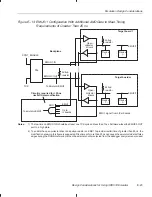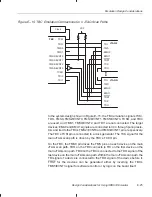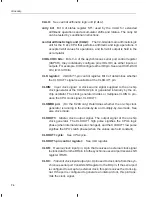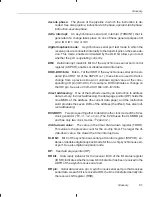
Emulation Design Considerations
E-19
Design Considerations for Using XDS510 Emulator
Of the following two cases, the worst-case path delay is calculated to deter-
mine the maximum system test clock frequency.
Example E–3. Key Timing for a Single-Processor System Without Buffering (SPL)
t
pd
ǒ
TCK-DTMS
Ǔ
+
ƪ
t
d
ǒ
DTMSmax
Ǔ
)
t
d
ǒ
DTCKHmin
Ǔ
)
t
su
ǒ
TTMS
Ǔ
ƫ
t
TCKfactor
+
(31 ns
)
2 ns
)
10 ns)
0.4
+
107.5 ns, or 9.3 MHz
t
pd
ǒ
TCK-DTDI
Ǔ
+
ƪ
t
d
ǒ
TTDO
Ǔ
)
t
d
ǒ
DTCKLmax
Ǔ
)
t
su
ǒ
DTDLmin
Ǔ
ƫ
t
TCKfactor
+
(15 ns
)
16 ns
)
7 ns)
0.4
+
9.5 ns, or 10.5 MHz
In this case, the TCK-to-DTMS/DTDL path is the limiting factor.
Example E–4. Key Timing for a Single- or Multiprocessor-System With Buffered Input
and Output (SPL)
t
pd (TCK-TDMS)
+
ƪ
t
d (DTMSmax)
)
t
ǒ
DTCKHmin
Ǔ
)
t
su (TTMS)
)
t
(bufskew)
ƫ
t
TCKfactor
+
(31 ns
)
2 ns
)
10 ns
)
1.35 ns)
0.4
+
110.9 ns, or 9.0 MHz
t
pd (TCK–DTDI)
+
ƪ
t
d (TTDO)
)
t
d
ǒ
DTCKLmax
Ǔ
)
t
su (DTDLmin
)
)
t
d (bufskew)
ƫ
t
TCKfactor
+
120 ns, or 8.3 MHz
+
(15 ns
)
15 ns
)
7 ns
)
10 ns)
0.4
In this case, the TCK-to-DTDI path is the limiting factor.
















































